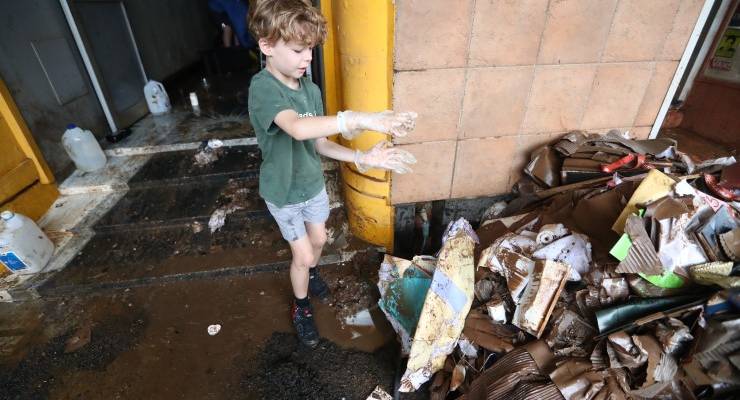
The National Recovery and Resilience Agency was set up in May last year with a budget of $900 million or so. It oversees billions in potential disaster relief payments and is headed by Shane Stone, a former Northern Territory chief minister and Liberal Party federal president.
For his work as coordinator-general, Stone gets a very handy $591,904 a year, part of the approximately $1.5 million spent on executive remuneration. And over the past week, with swathes of eastern Australia inundated with catastrophic levels of rainfall, Stone has become best known for telling people off for living in flood-prone areas.
“You’ve got people who want to live among the gum trees — what do you think is going to happen? Their house falls in the river, and they say it’s the government’s fault,” Stone told The Sydney Morning Herald in remarks that have led Labor to demand his sacking.
Maybe those houses wouldn’t fall into the river if his agency had done more work on mitigation, what it was actually set up to do.
At its launch last year, Stone talked about the importance of rebuilding communities to be resilient: “The Insurance Council reports we spend 97% on the clean-up and 3% on mitigation, preparedness, and resilience. We can never flood-, drought- or fire-proof the nation, but we can be better prepared and mitigate the impact.”
The agency does, in theory, oversee a lot of recovery and resilience funding, some $2.8 billion on the Black Summer bushfires and $1.5 billion on the north Queensland floods, which made up the bulk of its focus, according to its last annual review.
Those are some big numbers. But the Queensland and NSW flooding disasters have drawn attention to the money that hasn’t been spent. The $4.8 billion Emergency Response Fund, overseen by the agency, is yet to spend a cent on disaster recovery or building readiness projects.
According to the agency and minister responsible, Bridget McKenzie, the fund, which has accrued nearly $800 million in interest since it was launched in 2019, is working as planned, as an option of last resort to be touched only when all other sources of cash are exhausted.
Another caveat means the fund can spend only $150 million a year on the emergency response, and $50 million on resilience.
But not all of that has been spent by the government either.
Some of the Emergency Response Fund went to the National Flood Mitigation Infrastructure Program. But expenditure was, inexplicably, capped at $50 million, which meant more than $150 million in applications for flood mitigation projects, many in Queensland, weren’t funded.
Look long and hard enough at any of the big numbers being spun around disaster funding and holes appear. Take the $17 billion the government claims it spent on disaster relief over the past three years. Turns out that figure includes $13 billion in pandemic measures.
And where money has been spent, some of the regions bearing the brunt of the flooding crisis were inexplicably left out. Lismore, which was under 14 metres of water last week, is one of the most flood-prone towns in the country.
But it wasn’t classed as a priority area by the agency when doling out funds in the first round of its Preparing Australian Communities Program last year. The results of that grant application process are due soon and, as always, it’s worth keeping an eye on which projects are successful and where they are.
This story isn’t limited to the federal government. NSW has its own agency, Resilience NSW, set up after the Black Summer bushfires, and headed by widely lauded former Rural Fire Service chief Shane Fitzsimmons. It has a $1.4 billion budget, but has been criticised both for its perceived lacklustre response to the flood crisis and by some in the state government who can’t really figure out what it does.
There’s plenty of money out there for disaster recovery and relief. But the devastation in the northern rivers and across south-east Queensland is a sign it could be a lot better spent.








The headline billion $ figure that the government so loves and often quotes is the capital that it has invested to generate a return. The return on investment is then used for actual emergency response and mitigation.
Its also handy as the capital is considered “off budget” because its an “investment” and so doesn’t end up being considered as part of the government’s trillion $ debt. Its a bonus that the media misleads the community by using the capital figure, plus returns, as the measure of the government’s commitment for emergency response and mitigation.
However, its a con and nothing but accounting trickery.
What’s actually available is the return on capital, which in turn is subject to caveats and, of course, ministerial direction.
There is no point, other than to mislead and cut off options for future governments, for the government to “borrow” money to set up a fund for a specific purpose. Money should be allocated through the usual Budget process and four year forward estimates. What happens if the market crashes and the fund makes no money? No money for disaster relief?
Along the way their banking mates also get a big fat fee for managing the $$.
An interesting point. Stone gets paid $591, 000 for his job in overseeing the flood rehabilitation, Clem Jones was in charge of the rebuilding of Darwinn after the devastating cyclone in 1974 and was paid precisely nothing, zilch, zero for his tireless efforts.He did it out of thegoodness of his heart.But then again, Clem Jones was a Labor man, through and through.
Try looking at it from this government’s (that trophy cabinet of Schemo, Fraudberg, Plodd, Jethro, Fletch, Colbeck, McKenzie, Littleproud, Tehan, Pitt, Birmingham, Ley, Price, Cash, Reynolds, Robert, Taylor, Hawke, Morton, Sukka, Hume, Seselja, Gillespie, Wilson, Wood, Hastie Howarth et al) point of view side?
They’re going to need that promised/unspent/show money for the Budget, to pie-in-the-sky fund their pie-in-the-sky promises, to salt away in their pork barrels, to buy votes? And any other way they can scheme to have our cake and eat it too.
Tudge too. He really left the ministry only in the last week and should be included in the list.
The rest of ’em couldn’t hide him in plain sight anymore.
Same as the insurance industry – who don’t offer flood insurance in Lismore – because there is no risk involved, it will happen, so why throw good money at planned stupidity?
Let me guess – does Shane Stone live in Sydney? If so, he needs to move house – if his own advice is listening to, that is.
Well, with his rort of a retainer there’s no chance he’ll have to move to a house amongst the gum trees, where you go to find a house if you can’t really afford one. Stone is typical of the smug, sneering, richly overpaid LNP rogues who have wheedled themselves into every over-remunerated nook and cranny of ‘public service’ in the country.
Shane Stone lectures people on where they should live but does nothing to make himself less of a medical liability. I wonder how he got that well-paid job in the first place? I am sure there would be more qualified and healthier candidates.
I agree with Stone, el Nina is a predictable event. Lismore floods nearly every decade and yet still manages to stand there with its proud middle finger in defiance to nature. That seems to sum up their total commitment to dealing with these natural events.
On the other hand there is the Regenerative Agriculture-based argument that the ‘droughts and flooding rains’ paradigm is a man-made phenomenon. For them industrial farming practises (almighty man is in charge, bend to his will) have rid Australia of the top soils that were designed to soak up rain in situ, and what it can’t absorb runs off without taking the best bits (humus) to drown them in the nearest ocean.
The emasculation of Australia continues, only the loving, gentle bosom of a politician keeps us going with a happy smile (and all they want is money); and the quality of those will determine our future. Noice. Very noice.
Poetic & pragmatic, a rare combination.
Thank you.